Previous issues
- Page Path
- HOME > Browse Articles > Previous issues
- [English]
- Powder Injection Molding of Translucent Alumina using Supercritical Fluid Debinding
- Hyung Soo Kim, Jong Min Byun, Myung Jin Suk, Young Do Kim
- J Korean Powder Metall Inst. 2014;21(6):407-414. Published online December 1, 2014
- DOI: https://doi.org/10.4150/KPMI.2014.21.6.407
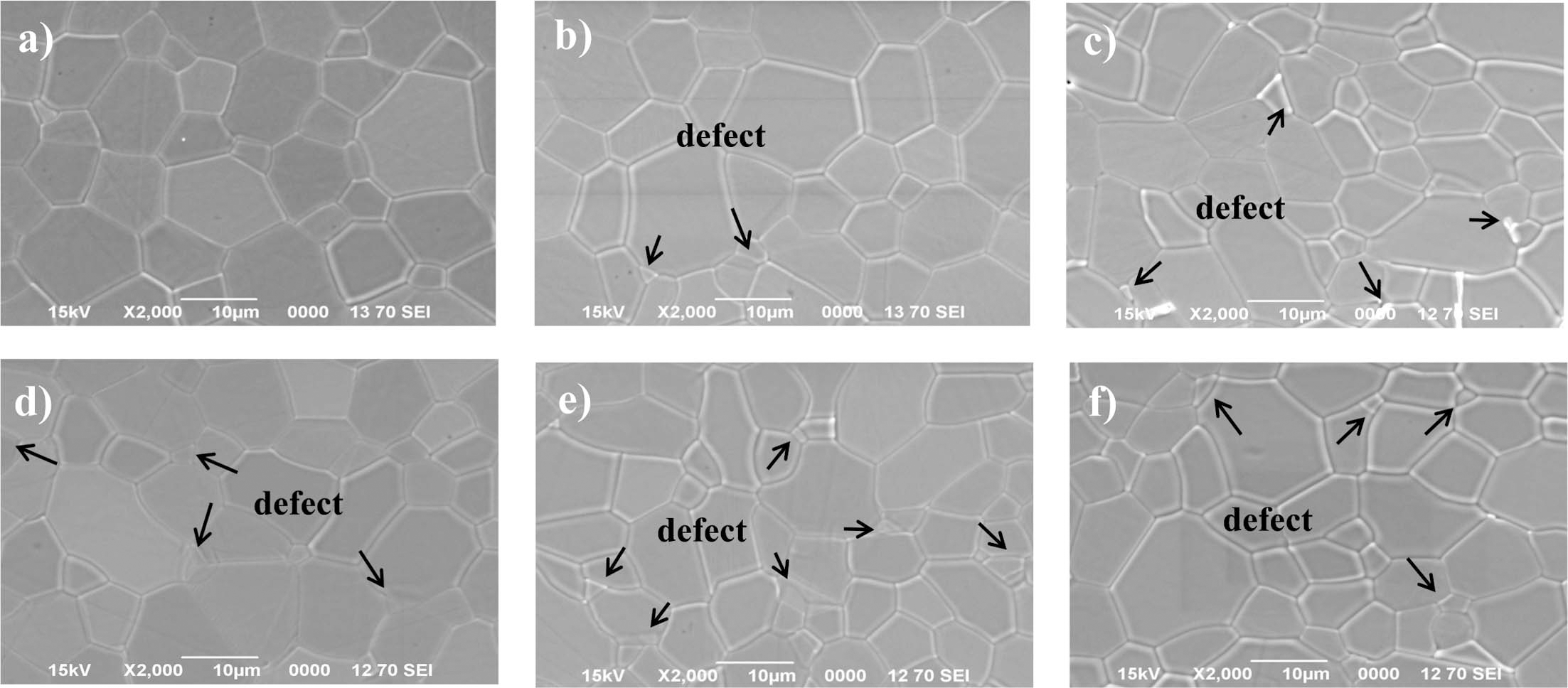
- 512 View
- 1 Download
- 1 Citations
-
 Abstract
Abstract
 PDF
PDF The powder injection molding process having advantages in manufacturing three-dimensional precision parts essentially requires a debinding process before sintering to remove the binders used for preparing feedstock. In this study, powder injection molding of translucent alumina was performed, and carbon dioxide (CO2) is used as a supercritical fluid that makes it possible to remove a large amount of binder, which is paraffin wax. The relationship between the optical property of translucent alumina and the debinding condition (temperature and pressure) of supercritical CO2 was investigated. As temperature and pressure increased, extraction rate of the binder showed rising tendency and average grain size after sintering process was relatively fine. On the other hand, optical transmittance was reduced. As a result, the debinding condition at 50° and 20 MPa that represents the lowest extraction rate, 8.19 × 10−3 m2/sec, corresponds to the largest grain size of 14.7 μm and the highest optical transmittance of 45.2%.
-
Citations
Citations to this article as recorded by- Experimental and numerical analysis of effects of supercritical carbon dioxide debinding on Inconel 718 MIM components
Dugauguez Olivier, Agne Aboubabky, Jimenez-Morales Antonia, Torralba José Manuel, Barriere Thierry
Powder Technology.2019; 355: 57. CrossRef
- Experimental and numerical analysis of effects of supercritical carbon dioxide debinding on Inconel 718 MIM components
- [Korean]
- Microstructure and Elevated Temperature Strength of W-ZrC Composites with Micrometric and Nanosized ZrC Particles
- Yoon Soo Han, Sung-Soo Ryu
- J Korean Powder Metall Inst. 2014;21(6):415-421. Published online December 1, 2014
- DOI: https://doi.org/10.4150/KPMI.2014.21.6.415
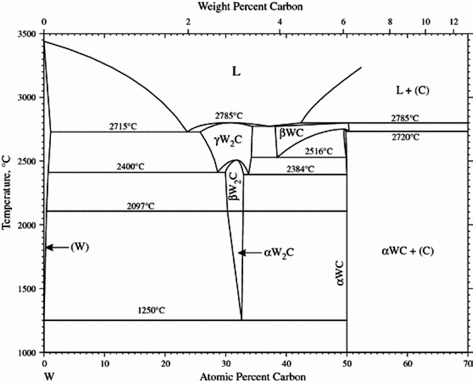
- 440 View
- 1 Download
-
 Abstract
Abstract
 PDF
PDF W-10vol.%ZrC composites reinforced by micrometric and nanosized ZrC particles were prepared by hot-pressing of 25 MPa for 2 h at 1900°C. The effect of ZrC particle size on microstructure and mechanical properties at room temperature and elevated temperatures was investigated by X-ray diffraction analysis, scanning electron microscope and transmission electron microscope observations and the flexural strength test of the W-ZrC composite. Microstructural analysis of the W-ZrC composite revealed that nanosized ZrC particles were homogeneously dispersed in the W matrix inhibiting W grain growth compared to W specimen with micrometric ZrC particle. As a result, its flexural strength was significantly improved. The flexural strength at room temperature for W-ZrC composite using nanosized ZrC particle being 740 MPa increased by around 2 times than that of specimen using micrometric ZrC particle which was 377 MPa. The maximum strength of 935 MPa was tested at 1200°C on the W composite specimen containing nanosized ZrC particle.
- [Korean]
- Hydrogen Reduction Behavior of Oxide Scale in Water-atomized Iron Powder
- Hea-Min Shin, Kyeong-Ho Baik
- J Korean Powder Metall Inst. 2014;21(6):422-428. Published online December 1, 2014
- DOI: https://doi.org/10.4150/KPMI.2014.21.6.422
- 666 View
- 1 Download
- 1 Citations
-
 Abstract
Abstract
 PDF
PDF In this study, the reduction kinetics and behaviors of oxides in the water-atomized iron powder have been evaluated as a function of temperature ranging 850-1000°C in hydrogen environment, and compared to the reduction behaviors of individual iron oxides including Fe2O3, Fe3O4 and FeO. The water-atomized iron powder contained a significant amount of iron oxides, mainly Fe3O4 and FeO, which were formed as a partially-continuous surface layer and an inner inclusion. During hydrogen reduction, a significant weight loss in the iron powder occurred in the initial stage of 10 min by the reduction of surface oxides, and then further reduction underwent slowly with increasing time. A higher temperature in the hydrogen reduction promoted a high purity of iron powder, but no significant change in the reduction occurred above 950°C. Sequence reduction process by an alternating environment of hydrogen and inert gases effectively removed the oxide scale in the iron powder, which lowered reduction temperature and/or shortened reduction time.
-
Citations
Citations to this article as recorded by- Carbon Co-Deposition During Gas Reduction of Water-Atomized Fe-Cr-Mo Powder
B. Ali, S.H. Choi, S.J. Seo, D.Y. Maeng, C.G. Lee, T.S. Kim, K.T. Park
Archives of Metallurgy and Materials.2017; 62(2): 1119. CrossRef
- Carbon Co-Deposition During Gas Reduction of Water-Atomized Fe-Cr-Mo Powder
- [Korean]
- High-frequency Magnetic Properties of Ni-Zn-Co Ferrites Used for Mangetic Shielding in NFC
- Yo-Han Ryu, Sung-Soo Kim
- J Korean Powder Metall Inst. 2014;21(6):429-433. Published online December 1, 2014
- DOI: https://doi.org/10.4150/KPMI.2014.21.6.429
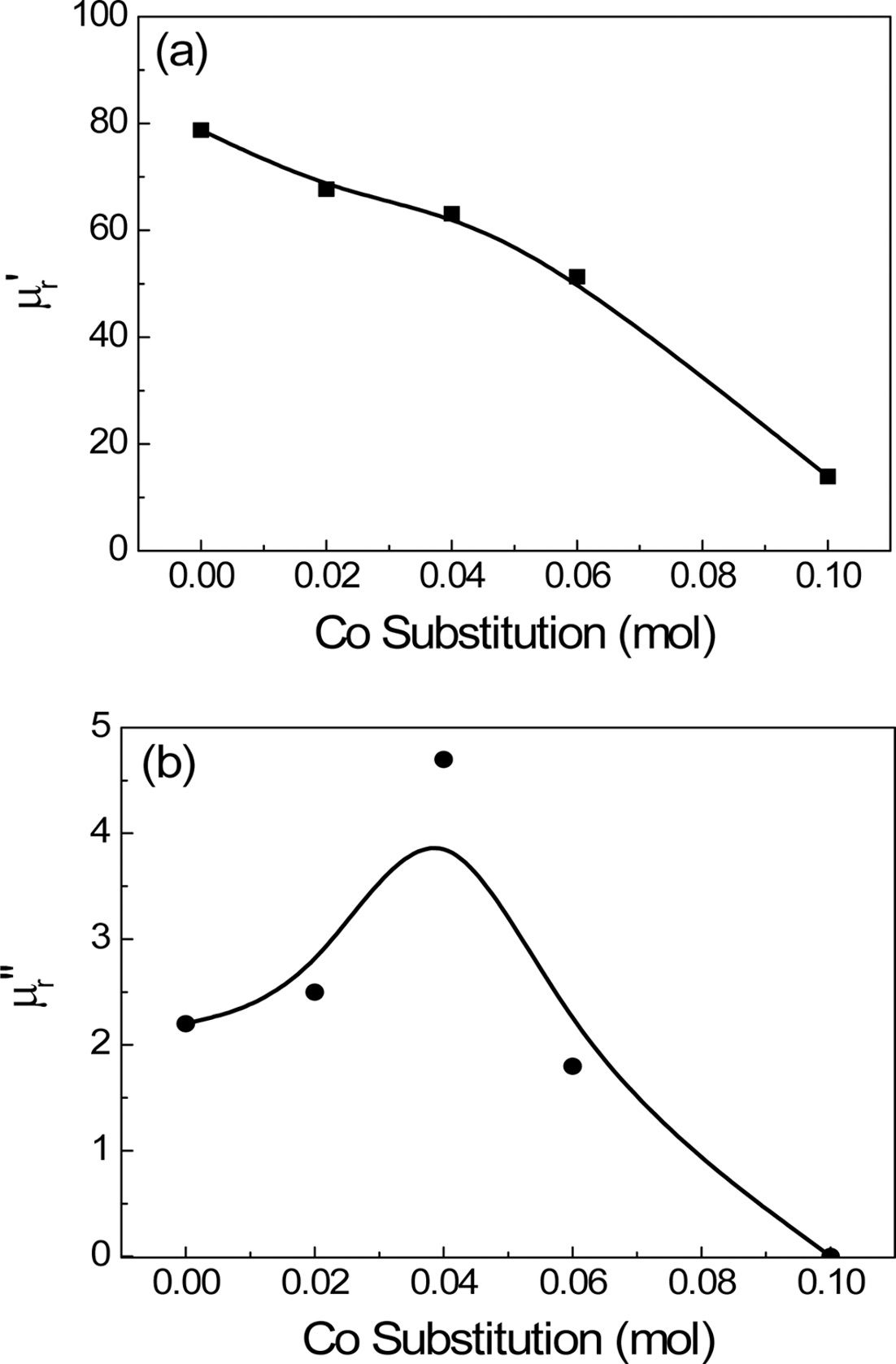
- 348 View
- 0 Download
-
 Abstract
Abstract
 PDF
PDF This study investigated the magnetic properties and frequency dispersion of complex permeability of Ni-Zn-Co ferrites used for magnetic shielding in near field communication (NFC) system. The sintered specimens of (Ni0.7Zn0.3)1-xCoxFe2O4 composition were prepared by the conventional ceramic processing. The coercive force and saturation magnetization were measured by vibrating sample magnetometer. The complex permeability was measured by RF impedance analyzer in the range of 1 MHz~1.8 GHz. The coercive force increased and saturation magnetization decreased with increasing the Co substitution. The real and imaginary parts of complex permeability decreased and the resonance frequency increased with Co substitution, which was attributed to the increase in crystal anisotropy field and reduction in saturation magnetization. The effect of Co substitution could be found in reducing the magnetic loss to nearly zero at the operating frequency of NFC (13.56 MHz).
- [Korean]
- Effect of Deposition Temperature on the Property of Pyrolytic SiC Fabricated by the FBCVD Method
- Yeon-Ku Kim, Weon-Ju Kim, SungHwan Yeo, Moon-Sung Cho
- J Korean Powder Metall Inst. 2014;21(6):434-440. Published online December 1, 2014
- DOI: https://doi.org/10.4150/KPMI.2014.21.6.434
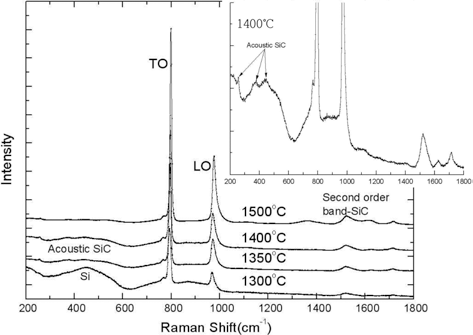
- 489 View
- 4 Download
- 1 Citations
-
 Abstract
Abstract
 PDF
PDF Silicon carbide(SiC) layer is particularly important tri-isotropic (TRISO) coating layers because it acts as a miniature pressure vessel and a diffusion barrier to gaseous and metallic fission products in the TRISO coated particle. The high temperature deposition of SiC layer normally performed at 1500-1650°C has a negative effect on the property of IPyC layer by increasing its anisotropy. To investigate the feasibility of lower temperature SiC deposition, the influence of deposition temperature on the property of SiC layer are examined in this study. While the SiC layer coated at 1500°C obtains nearly stoichiometric composition, the composition of the SiC layer coated at 1300-1400°C shows discrepancy from stoichiometric ratio(1:1). 3-7 μm grain size of SiC layer coated at 1500°C is decreased to sub-micrometer (<1 μm) -2 μm grain size when coated at 1400°C, and further decreased to nano grain size when coated at 1300- 1350°C. Moreover, the high density of SiC layer (≥3.19 g/cm3) which is easily obtained at 1500°C coating is difficult to achieve at lower temperature owing to nano size pores. the density is remarkably decreased with decreasing SiC deposition temperature.
-
Citations
Citations to this article as recorded by- High-temperature thermo-mechanical behavior of functionally graded materials produced by plasma sprayed coating: Experimental and modeling results
Kang Hyun Choi, Hyun-Su Kim, Chang Hyun Park, Gon-Ho Kim, Kyoung Ho Baik, Sung Ho Lee, Taehyung Kim, Hyoung Seop Kim
Metals and Materials International.2016; 22(5): 817. CrossRef
- High-temperature thermo-mechanical behavior of functionally graded materials produced by plasma sprayed coating: Experimental and modeling results
- [Korean]
- Synthesis of Silica-Core Gold-Satellite Nanoparticles and Their Surface-enhanced Raman Scattering Based Sensing Application
- Hyun Ji Choi, Young-Kuk Kim, Seok-Young Yoon, Youn-Kyoung Baek
- J Korean Powder Metall Inst. 2014;21(6):441-446. Published online December 1, 2014
- DOI: https://doi.org/10.4150/KPMI.2014.21.6.441
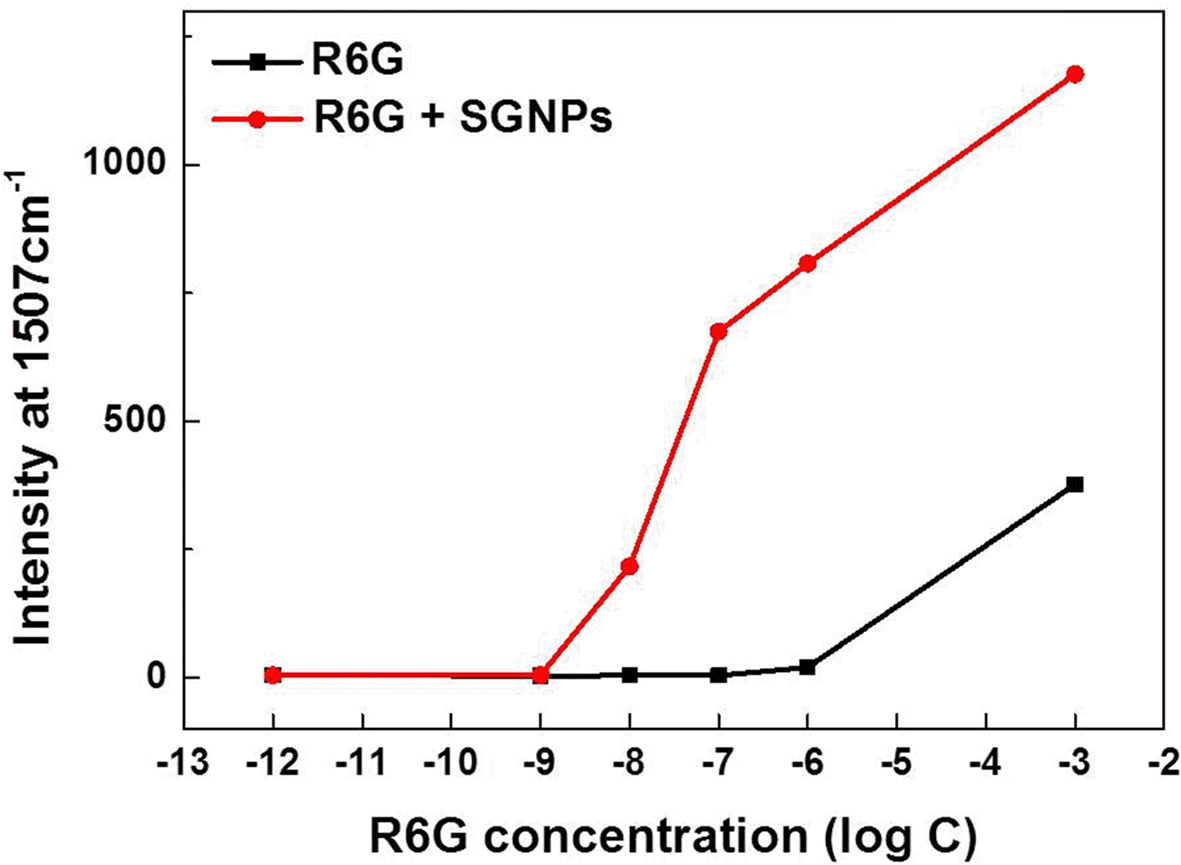
- 477 View
- 0 Download
-
 Abstract
Abstract
 PDF
PDF In this study, we synthesize silica-core gold-satellite nanoparticles (SGNPs) for the surface-enhanced Raman scattering (SERS) based sensing applications. They consist of gold satellite nanoparticles (AuNPs) fixed on the silica core nanoparticles, which sizes of AuNPs can be tunned by varying the amount of reactants (growth solution and reducing agent). Their surface plasmon resonance (SPR) properties were characterized by using UV-vis spectroscopy, showing that the growth of AuNPs on silica cores leads to the light absorption in the longer wavelength region. Furthermore, the size increase of AuNPs exhibited the dramatic change in SERS activity due to the formation of hot spots. The optimized SGNPs showing enhancement factor~3.8×106 exhibited a detection limit of rhodamine 6G (R6G) as low as 10−8 M. These findings suggest the importance of size control of SGNPs and their SPR properties to develop highly efficient SERS sensors.
- [Korean]
- Effect of Oxygen Content in the Tungsten Powder Fabricated by Electrical Explosion of Wire Method on the Behavior of Spark-Plasma Sintering
- Cheol-Hee Kim, Seong Lee, Byung-Kee Kim, Ji Soon Kim
- J Korean Powder Metall Inst. 2014;21(6):447-453. Published online December 1, 2014
- DOI: https://doi.org/10.4150/KPMI.2014.21.6.447
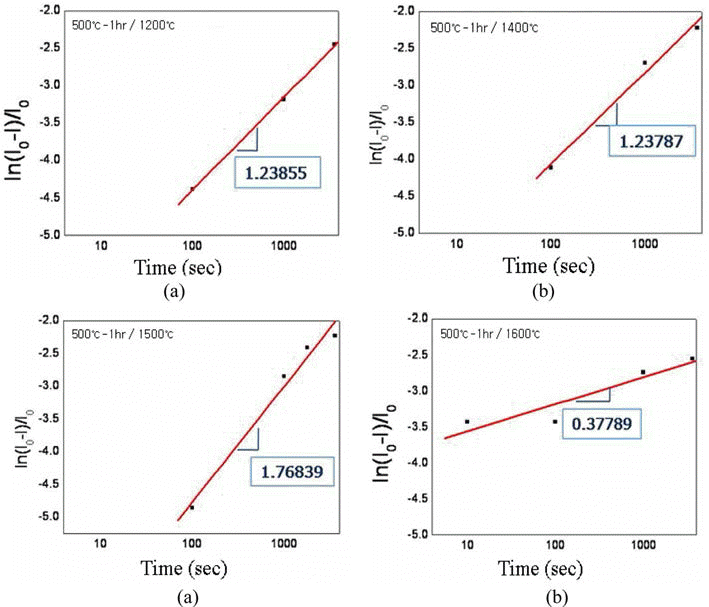
- 358 View
- 1 Download
- 1 Citations
-
 Abstract
Abstract
 PDF
PDF Effect of oxygen content in the ultrafine tungsten powder fabricated by electrical explosion of wire method on the behvior of spark plasma sintering was investigated. The initial oxygen content of 6.5 wt% of as-fabricated tungsten powder was reduced to 2.3 and 0.7 wt% for the powders which were reduction-treated at 400°C for 2 hour and at 500°C for 1h in hydrogen atmosphere, respectively. The reduction-treated tungsten powders were spark-plasma sintered at 1200-1600°C for 100-3600 sec. with applied pressure of 50 MPa under vacuum of 0.133 Pa. Maximun sindered density of 97% relative density was obtained under the condition of 1600°C for 1h from the tungsten powder with 0.7 wt% oxygen. Sintering activation energy of 95.85 kJ/mol−1 was obtained, which is remarkably smaller than the reported ones of 380~460 kJ/mol−1 for pressureless sintering of micron-scale tungsten powders.
-
Citations
Citations to this article as recorded by- Effect of Powder Mixing Process on the Characteristics of Hybrid Structure Tungsten Powders with Nano-Micro Size
Na-Yeon Kwon, Young-Keun Jeong, Sung-Tag Oh
Journal of Korean Powder Metallurgy Institute.2017; 24(5): 384. CrossRef
- Effect of Powder Mixing Process on the Characteristics of Hybrid Structure Tungsten Powders with Nano-Micro Size
- [Korean]
- Characteristics of the Ceramic Filter with the Control of Particle Size and Graphite Additive for the Hazardous Particle and Gas Removal
- Eul-Hun Cho, Kun-Jae Lee
- J Korean Powder Metall Inst. 2014;21(6):454-459. Published online December 1, 2014
- DOI: https://doi.org/10.4150/KPMI.2014.21.6.454

- 351 View
- 2 Download
-
 Abstract
Abstract
 PDF
PDF In this study, the porous ceramic filter was developed to be able to remove both dust and hazardous gas contained in fuel gas at high temperature. The porous ceramic filters were fabricated and used as a catalyst support. And the effects have been investigated such as the mean particle size, organic content and addition of foaming agent on the porosity, compressive strength and pressure drop of ceramic filters. With the increase of mean powder size and the organic content for the cordierite filter, the porosity was increased, but the compressive strength and pressure drop were decreased. From the results of the research, the optimum condition for the fabrication of ceramic filters could be acquired and they had the porosity of 58%, the compressive strength of 13.4 MPa and the pressure drop of 250 Pa. It was expected that this ceramic filter was able to be applied to the glass melting furnace, combustor, and dust/toxic gas removal filter.
- [Korean]
- Investigation on the Sintering Behavior and Mechanical Properties of Al-Zn-Mg Alloy Powders Mixed with Al-Si-SiC Composite Powders
- Gwang-Joo Jang, Kyung Tae Kim, Sangsun Yang, Yong-Jin Kim, Yong-Ho Park
- J Korean Powder Metall Inst. 2014;21(6):460-466. Published online December 1, 2014
- DOI: https://doi.org/10.4150/KPMI.2014.21.6.460
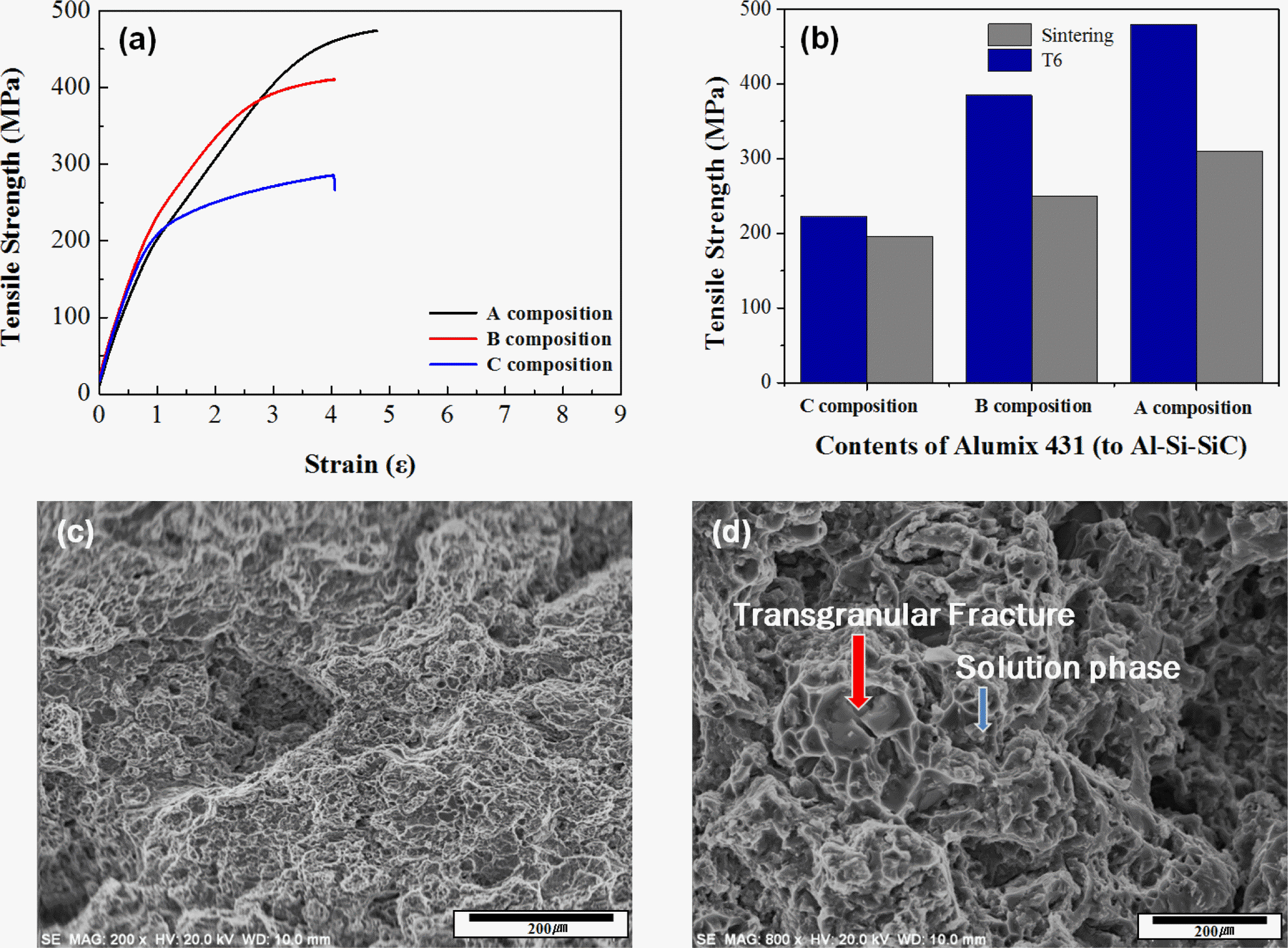
- 480 View
- 1 Download
- 1 Citations
-
 Abstract
Abstract
 PDF
PDF Al-Si-SiC composite powders with intra-granular SiC particles were prepared by a gas atomization process. The composite powders were mixed with Al-Zn-Mg alloy powders as a function of weight percent. Those mixture powders were compacted with the pressure of 700 MPa and then sintered at the temperature of 565-585°C. T6 heat treatment was conducted to increase their mechanical properties by solid-solution precipitates. Each relative density according to the optimized sintering temperature of those powders were determined as 96% at 580°C for Al-Zn-Mg powders (composition A), 97.9% at 575°C for Al-Zn-Mg powders with 5 wt.% of Al-Si-SiC powders (composition B), and 98.2% at 570°C for Al-Zn-Mg powders with 10 wt.% of Al-Si-SiC powders (composition C), respectively. Each hardness, tensile strength, and wear resistance test of those sintered samples was conducted. As the content of Al-Si-SiC powders increased, both hardness and tensile strength were decreased. However, wear resistance was increased by the increase of Al-Si-SiC powders. From these results, it was confirmed that Al-Si-SiC/Al-Zn-Mg composite could be highly densified by the sintering process, and thus the composite could have high wear resistance and tensile strength when the content of Al-Si-SiC composite powders were optimized.
-
Citations
Citations to this article as recorded by- Effect of Tin Addition on the Melting Temperatures and Mechanical Properties of Al-Si-Cu Brazing Filler Metals
Min Sang Kim, Chun Woong Park, Jong Min Byun, Young Do Kim
Korean Journal of Materials Research.2016; 26(7): 376. CrossRef
- Effect of Tin Addition on the Melting Temperatures and Mechanical Properties of Al-Si-Cu Brazing Filler Metals
- [Korean]
- Effect of the SiC Size on the Thermal and Mechanical Properties of Reaction-bonded Silicon Carbide Ceramics
- Chang-Sup Kwon, Yoon-Suk Oh, Sung-Min Lee, Yoonsoo Han, Hyun-Ick Shin, Youngseok Kim, Seongwon Kim
- J Korean Powder Metall Inst. 2014;21(6):467-472. Published online December 1, 2014
- DOI: https://doi.org/10.4150/KPMI.2014.21.6.467
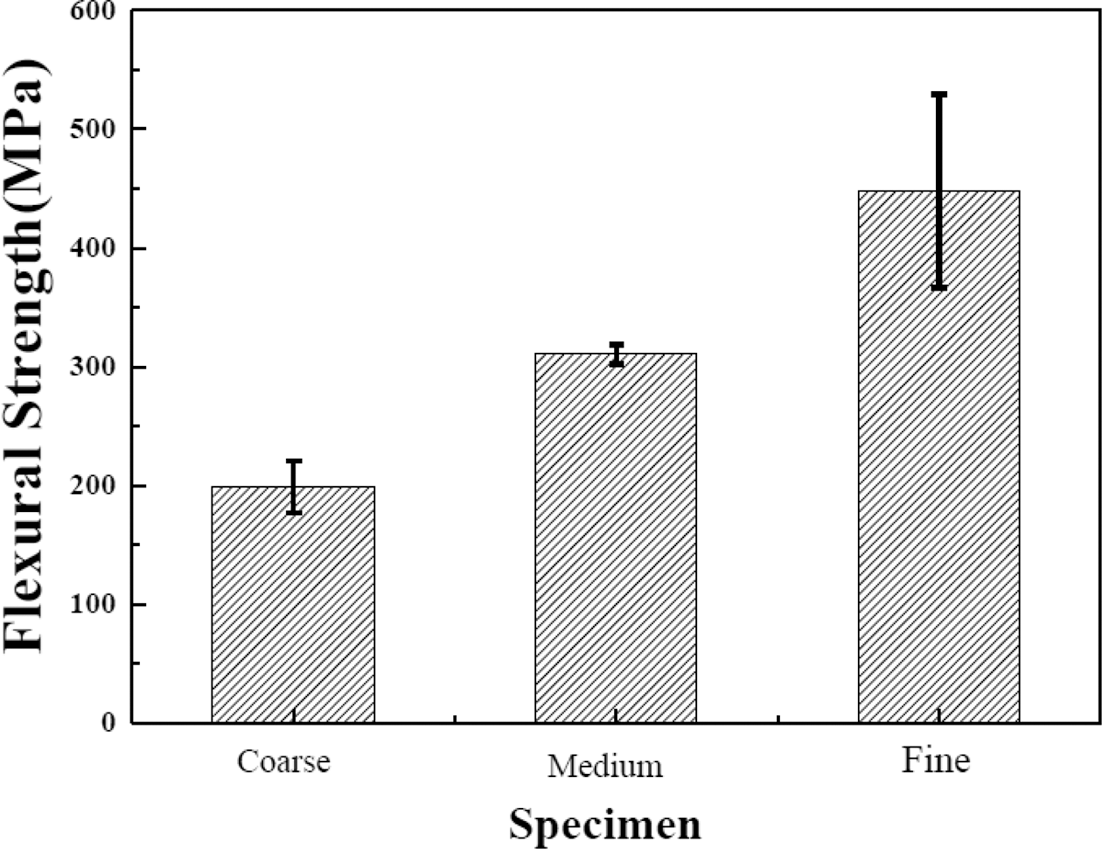
- 826 View
- 11 Download
- 3 Citations
-
 Abstract
Abstract
 PDF
PDF RBSC (reaction-bonded silicon carbide) represents a family of composite ceramics processed by infiltrating with molten silicon into a skeleton of SiC particles and carbon in order to fabricate a fully dense body of silicon carbide. RBSC has been commercially used and widely studied for many years, because of its advantages, such as relatively low temperature for fabrication and easier to form components with near-net-shape and high relative density, compared with other sintering methods. In this study, RBSC was fabricated with different size of SiC in the raw material. Microstructure, thermal and mechanical properties were characterized with the reaction-sintered samples in order to examine the effect of SiC size on the thermal and mechanical properties of RBSC ceramics. Especially, phase volume fraction of each component phase, such as Si, SiC, and C, was evaluated by using an image analyzer. The relationship between microstructures and physical properties was also discussed.
-
Citations
Citations to this article as recorded by- Structural and Mechanical Properties of SiC-Rich By-Products of the Metal Grade Si Process
Thomas Hafner, Jonas Hafner, Frank Kimm, Vira Bovda, Oleksandr Bovda, Oleksandr Kuprin, Anatoliy Pikalov, Kostiantyn Lentsov, Pavlo Schikhaylo, Yriy Onyschuk, Andriy Tarasuk, Viktoriya Podhurska, Bogdan Vasyliv, Oleksandr Shcheretsky, Ihor Vorona, Roman Y
Materials Science Forum.2024; 1113: 87. CrossRef - Effect of Y2O3 Additive Amount on Densification of Reaction Bonded Silicon Carbides Prepared by Si Melt Infiltration into All Carbon Preform
Kyeong-Sik Cho, Min-Ho Jang
Korean Journal of Materials Research.2021; 31(5): 301. CrossRef - Mechanical Strength Values of Reaction-Bonded-Silicon-Carbide Tubes with Different Sample Size
Seongwon Kim, Soyul Lee, Yoon-Suk Oh, Sung-Min Lee, Yoonsoo Han, Hyun-Ick Shin, Youngseok Kim
Journal of Korean Powder Metallurgy Institute.2017; 24(6): 450. CrossRef
- Structural and Mechanical Properties of SiC-Rich By-Products of the Metal Grade Si Process
- [Korean]
- Research Trend of Electrode Materials for Lithium Rechargeable Batteries
- Jae-won Lee, Woo-Byoung Kim
- J Korean Powder Metall Inst. 2014;21(6):473-479. Published online December 1, 2014
- DOI: https://doi.org/10.4150/KPMI.2014.21.6.473
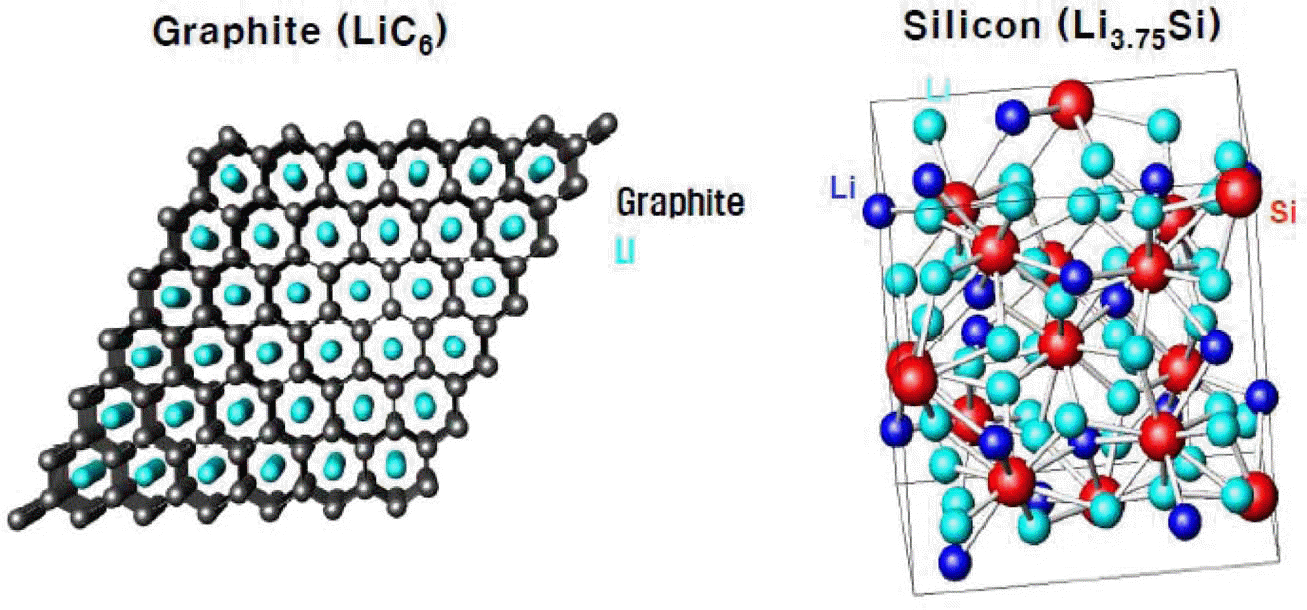
- 2,017 View
- 32 Download
- 7 Citations
-
 PDF
PDF -
Citations
Citations to this article as recorded by- A neuro-fuzzy system to evaluate the remaining useful life of the lithium-ion battery using the impedance spectrum in the overall range of SOCs
Min-Seong Kim, Abdul Shakoor Akram, Woojin Choi
Journal of Power Electronics.2025; 25(1): 103. CrossRef - Highly Stable and Rechargeable Lithium‐Ion Battery Using a Designed Organic PTVE‐Impregnated Porous Graphitic Carbon Composite
Ji-Won Son, Jae Seob Lee, Hyun Ho Choi, Fanglin Wu, Hong-Il Kim, Tae Ju Kang, Hyun Woo Kim, Shan Fang, Ying Liu, Jung Sang Cho, Amar Patil
International Journal of Energy Research.2025;[Epub] CrossRef - Hydrogen Reduction Behavior of NCM-based Lithium-ion Battery Cathode Materials
So-Yeong Lee, So-Yeon Lee, Dae-Hyeon Lee, Ho-Sang Sohn
journal of Korean Powder Metallurgy Institute.2024; 31(2): 163. CrossRef - Effect of Calcination Temperature on Ionic Conductivity of All-solid State Battery Electrolytes
Yu Taek Hong, Ji Min Im, Ki Sang Baek, Chan Gyu Kim, Seung Wook Baek, Jung Hyun Kim
New & Renewable Energy.2024; 20(2): 71. CrossRef - FeCO3/rGO Composites Prepared by CO2 Capture and Carbonate Conversion: Anode Material in Lithium-Ion Batteries with Enhanced Performance
Sanglim Lee, Gahwi Gu, Daeung Park, Hwiyun Im, Yongjae Lee, Junseok Moon, Weonho Shin, Hiesang Sohn
Membrane Journal.2024; 34(5): 253. CrossRef - Research Trend in Rock Salt Structured High Entropy Cathode
Minjeong Kim, Jahun Koo, Minjeong Kang, Juah Song, Chunjoong Kim
Ceramist.2022; 25(1): 90. CrossRef - Recovery of Co and Ni from Strong Acidic Solution by Cyanex 301
Yeon-Chul Cho, Ki-Hun Kim, Jae-Woo Ahn
Resources Recycling.2021; 30(6): 28. CrossRef
- A neuro-fuzzy system to evaluate the remaining useful life of the lithium-ion battery using the impedance spectrum in the overall range of SOCs
TOP
 kpmi
kpmi




 First
First Prev
Prev


